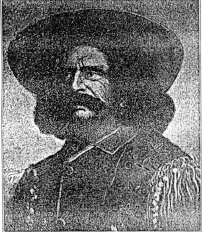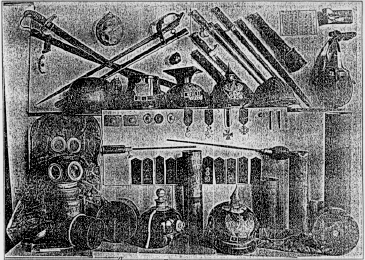
|
2 |
|
|
(handwritten below photo - "See C 2010") |
|
Major John G. Maher War Collection |
|
|
The above picture shows, in part, the collection of war trophies presented by Major John G. Maher to the Nebraska State Historical Society. These trophies were secured by Major Maher when overseas during 1918-19. They came chiefly from the neighborhoods of Soissons, Verdun, Metz. They include German and French helmets, swords, bayonets, scabbards, hand grenades, cartridges, shells, bread and sugar coupons, war medals and many other articles. This is a valuable addition to the Historical Society World War museum. |
|
|
A letter has recently been received
from Mrs. Susan Kearny Selfridge, a daughter of General
Philip Kearny. Mrs. Selfridge has prepared a lecture on
"Philip Kearny, Soldier and Patriot," and the cause for
which he fought, covering events of over half a century. The
purpose of the lecture, aside from doing honor to "Fighting
Phil. Kearny," is to further the cause of
Americanization. On the 21st day of December, 1866, seventy-nine soldiers from Fort Philip Kearny and two citizens, detached to protect a party of choppers who were procuring wood for the fort, were attacked by Indians, numbering between 1,500 and 2,000. The entire command was killed, including the leader, Brevet Lieutenant Colonel William J. Fetterman. This is the most shocking tragedy in the long struggle between the Indians of the plains and the white intruders, excepting the culminating battle on the Little Bighorn, called the Custer Massacre, which occurred ten years later less than, a hundred miles distant and in the same disputed territory. Its direct cause was the Powder River military expedition of 1865 and the establishing of a line of forts - Reno, Phil. Kearny and C. F. Smith - along the Bozeman road, in the summer of 1866, by Colonel Henry B. Carrington, of the Eighteenth Regiment U. S. Infantry. Colonel Carrington's command on this hazardous expedition comprised only the second battalion - eight companies of the regiment. The site for Fort Reno, at the intersection of the road by Crazy Woman's fork of Powder River, - then in Dakota -but now near the center of Johnson county, Wyoming, - was selected |
on July 12th, for Fort Phil. Kearny on July 14th, and for
Fort Smith on August 12th. |
|
|
3 |

(handwritten below photo - "See C 2382") D. Charles Bristol (Omaha Charley)
(Collector of the Bristol Exhibit of
Early Indian Relics in the Historical Society's Museum.) |
collection on exhibition in the rooms of the Nebraska
State Historical Society, where it has remained ever since.
When I was packing the collection at Homer for shipment to
the Historical Society, a Mr. Buck Walter, who lived there,
pressed upon Mr. Bristol his check of three hundred dollars
for one of the buffalo robes, but in vain; so the Historical
Society obtained the collection intact. Of course this
treasure is displayed at great disadvantage in the very
crowded space in the Society's rooms. (Continued from Page Two.) won the severest condemnation from the just. The report
of the commission which was appointed to investigate the
troubles with the Indians of the plains during the period
under consideration, made by General John B. Sanborn,
General N. B. Buford, and G. P. Beauvais, the celebrated
frontiersman and Indian trader, attributed the hostility of
the Indians to the causes adverted to, and directly to the
fact that though they had refused to sign the treaty imposed
upon them at Fort Laramie in June, yet immediately after
this refusal by the Indians who owned the Powder River
country to permit the use of the Montana road, a military
force was sent to fortify it by the erection of the three
forts along its course. |
|
4 |
|
|
By John L. Kennedy, Federal Fuel Administrator. (A paper read at the annual meeting of the Nebraska State Historical Society, January 13, 1920.) |
|
|
On October 16, 1917, Dr. Harry A. Garfield, United States fuel administrator, tendered me by telegraph the office of federal fuel administrator for Nebraska, and I accepted the appointment the same day. My formal certificate of appointment is dated October 17. At the request of Dr. Garfield I attended a conference of state fuel administrators held in Washington on October 26, at which the work of the fuel administration was outlined. Upon my return from Washington I at once organized for work in the state. In Nebraska there are six congressional
districts and ninety-three counties. An advisory committee
was appointed, consisting of one member from each
congressional district as follows: First district, John E.
Miller, Lincoln; second district, George W. Holdrege, Omaha;
third district, Mark D. Tyler, Norfolk; fourth district,
Frank W. Sloan, Geneva; fifth district, William H. Lanning,
Hastings; sixth district, Judge Robert R. Dickson,
O'Neill. The county was taken as the most satisfactory unit for organization purposes. I appointed the chairman in each county, and he made up his own committee. Selections were made without reference to party politics. In a few sparsely settled western counties the chairmen made no appointments and took charge of the work personally. In other counties committees were larger or smaller according to population and community requirements, the object being to have a member of the committee in each city or town. They averaged about seven or eight to a county, in all about seven hundred. On November 6, 1917, I appointed Fred
P. Loomis, of Omaha, assistant fuel administrator, and he
rendered excellent service in the distribution of coal
during the winter of 1917-18. At no time during the period of fuel
administration did Nebraska suffer seriously for lack of
fuel. Throughout the winter of 1917-18 sufficient coal could
have been obtained from usual sources of supply to meet all
requirements. The transportation facilities, however, were
inadequate. Coal cars, loaded and empty, were congested at
diversion points and terminals, and the free movement of
available coal was thereby delayed. The railroads also
lacked engines and equipment. Nebraska is a mineless state. Our problems related
largely to distribution. This was particularly true during
the winter of 1917-18, when the transportation system was
found to be unequal to the emergency. Every effort was made
to relieve the situation and release cars, but considerable
disorder and confusion prevailed for several months after my
appointment. Coal cars were not placed promptly for
unloading, and were frequently "bunched," so that coal
dealers were unable to unload them as they arrived. |
and Wyoming, and cars could not be diverted to any extent
from one railway to another. In the southwestern part of the
state, reached only by the Chicago, Burlington & Quincy
railway, much difficulty was experienced in preventing
actual suffering during the winter of 1917-18. In some
instances that railway furnished and transported coal in the
night to particular communities, to meet emergencies. These
conditions induced me to insist upon through joint rates
from all Wyoming and Colorado mines to all points in
Nebraska, so that coal cars might move freely from one line
to another at the most convenient junction or diversion
point. Such rates were eventually put into effect, to the
great advantage and relief of consumers throughout the
state. Soon after my appointment it became evident that great difficulty would be experienced in reaching correct margins, because of the imperfect bookkeeping methods of the retail dealers, and the lack of accurate records for previous years. My intention in the first instance was to establish prices in the different cities, towns and villages throughout the state. The county committees in Douglas and Lancaster counties investigated fully and reported specific prices for Omaha and Lincoln. These prices, with certain modifications, were put into effect in Omaha, December 19, 1917, and in Lincoln January 3, 1918. The prices in the two cities were substantially the same, differences in freight rates and local delivery charges being taken into account. Prices were established for the communities in Douglas and Lancaster counties outside of Omaha and Lincoln, to take effect February 1, 1918. Before establishing prices for the state at large, reports were called for from the several county committees, and I soon became convinced that the local price plan was impracticable and difficult of equitable application, because of the changing mine prices and transportation and other charges. Definite prices were then dropped, and maximum retail gross margins were established, on all coal and coke sold to consumers in Nebraska outside of Douglas and Lancaster counties, to take effect February 9, 1918. Those margins were on substantially the same basis as the prices in Douglas and Lancaster counties. On March 30, 1918, I made an order establishing maximum retail gross margins for the entire state, effective April first in that order coal dealers were required to post up and main- |
Vol II, no 3, part 2
Return to NE History & Record of Pioneer Days
© 1998, 1999, 2000, 2001 for NEGenWeb Project by Ted & Carole Miller
